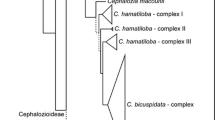Abstract
Intrageneric relationships in the genusBrachycome were investigated by the comparison of nucleotide sequences of the chloroplast genematK. Evolutionary trends of some morphological and cytological characters were estimated based on thematK tree. The results indicate thatBrachycome is divided into four major clades, and circumscription of superspecies based primarily on fruit morphology is not fully supported. Fruit morphology has evolved in parallel from simple to complex structures in several lineages. The ancestral basic chromosome number isx = 9, and lower chromosome numbers are the products of several dysploid reductions fromn = 9 in two of four major clades ofBrachycome.
Similar content being viewed by others
References
Adachi J., Watanabe K., Fukui K., Ohmido N., Kosuge K. (1997) Chromosomal location and reorganization of the 45S and 5S rDNA in theBrachyscome lineariloba complex (Asteraceae). J. Plant Res. 110: 371–377.
Bremer K. (1987) Tribal interrelationships of the Asteraceae. Cladistics 3: 210–253.
Carter C. R. (1978) The cytology ofBrachycome. II. The subgenusMetabrachycome: a general survey. Austral. J. Bot. 26: 699–706.
Davis G. L. (1948) Revision of the genusBrachycome Cass. Part I. Australian species. Proc. Linn. Soc. New South Wales 73: 142–241.
Davis G. L. (1949) Revision of the genusBrachycome Cass. Part III. Description of three new Australian species and some new locality records. Proc. Linn. Soc. New South Wales 74: 97–106.
Davis G. L. (1954) Supplementary notes on the genusBrachycome Cass. Descriptions of five new Australian species and some new locality records. Proc. Linn. Soc. New South Wales 79: 203–210.
Davis G. L. (1959) Two new Australian species ofBrachycome Cass. (Compositae). Muelleria 1: 111–113.
Denda T., Kosuge K., Watanabe K., Ito M., Suzuki Y., Short P. S., Yahara T. (1996) Intron length variation of the Adh gene inBrachyscome (Asteraceae). Plant Molec. Biol. 28: 1067–1073.
Donoghue M. J., Olmstead R. G., Smith J. F., Palmer J. D. (1992) Phylogenetic relationships of Dipsacales based onrbcL sequences. Ann. Missouri Bot. Gard. 79: 333–345.
Doyle J. J., Doyle J. L. (1987) A rapid DNA isolation procedure for small quantities of fresh leaf tissue. Phytochem. Bull. 19: 11–15.
Felsenstein J. (1985) Confidence limits on phylogenies: an approach using the bootstrap. Evolution 39: 783–791.
Felsenstein J. (1988) Phylogenies from molecular sequences: inference and reliability. Annual Rev. Genet. 22: 521–565.
Johnson L. A., Soltis D. E. (1994)matK DNA sequences and phylogenetic reconstruction in Saxifragaceae s. str. Syst. Bot. 19: 143–156.
Johnson L. A. (1995) Phylogenetic inference in Saxifragaceae sense stricto andGilia (Polemoniaceae) usingmatK sequences. Ann. Missouri Bot. Gard. 82: 149–175.
Maddison D. R. (1991) The discovery and importance of multiple islands of most-parsimonious trees. Syst. Zool. 40: 315–328.
Maddison W. P., Maddison D. R. (1992) MacClade: Analysis of phylogeny and character evolution. Version 3.0. Sinauer, Sunderland, MA.
Mayr E. (1942) Systematics and the origin of species. Columbia University Press, New York.
McClintock B. (1984) The significance of responses of the genome to challenge. Science 226: 792–801.
Nakazawa M., Wakabayashi M., Ono M., Murata J. (1997) Molecular phylogenetic analysis ofChrysosplenium (Saxifragaceae) in Japan. J. Plant Res. 110: 265–274.
Ooi K., Endo Y., Yokohama J., Murakami N. (1995) Useful primer designs to amplify DNA fragments of the plastid genematK from angiosperm plants. J. Jap. Bot. 70: 328–331.
Short P. S. (1986) Chromosome number reports in Australian Asteraceae. Taxon 35: 610.
Smith-White S., Carter C. R., Stace H. M. (1970) The cytology ofBrachycome. I. The subgenusEubrachycome: a general survey. Austral. J. Bot. 18: 99–125.
Soltis D. E., Kuzoff R. K., Conti E., Goenall R., Ferguson K. (1996)matK andrbcL gene sequence data indicate that Saxifraga (Saxifragaceae) is polyphyletic. Amer. J. Bot. 83: 371–382.
Steel K. P., Vilgalys R. (1994) Phylogenetic analyses ofPolemoniaceae using nucleotide sequences of the plastid genematK. Syst. Bot. 19: 126–142.
Swofford D. L., (1991) PAUP: Phylogenetic analysis using parsimony, version 3.1.1. Illinois National History Survey Champaign.
Watanabe K., Short P. S. (1992) Chromosome number determinations inBrachyscome Cass. (Asteraceae: Astereae) with comments on species delimitation, relationships and cytogeography. Muelleria 7: 457–471.
Watanabe K., Smith-White S. (1987) Phyletic and evolutionary relationships ofBrachyscome lineariloba (Compositae). Plant Syst. Evol. 157: 121–141.
Watanabe K., Carter C. R., Smith-White S. (1975) The cytology ofBrachycome lineariloba. 5. Chromosome relationships and phylogeny of the race A cytodemes (n = 2). Chromosoma 52: 383–397.
Watanabe K., Carter C. R., Smith-White S. (1976) The cytology ofBrachycome lineariloba. 6. A synchronous chromosome condensation and meiotic behavior inB. lineariloba A (n = 2) ×B. campylocarpa A (n = 4). Chromosoma 57: 319–331.
Watanabe K., Carter C. R., Smith-White S. (1985) The cytology ofBrachycome lineariloba 9. Chromosomal heterogeneity in natural populations of cytodeme C (2n = 16). Canad. J. Genet. Cytol. 27: 410–420.
Watanabe K., Short P. S., Kosuge K., Smith-White S. (1991) The cytology ofBrachyscome Cass. (Asteraceae: Astereae). 11. Hybridization betweenB. goniocarpa (n = 4) andB. dichromosomatica (n = 2). Austral. J. Bot. 39: 475–485.
Watanabe K., Denda T., Suzuki Y., Kosuge K., Ito M., Short P. S., Yahara T. (1996a) Chromosomal and molecular evolution inBrachyscome (Astereae). In: Hind D. J. N., Beentje H. J. (eds.) Compositae: Systematics. Proc. Int. Compositae Conf. Kew, 1994, pp. 705–722. Royal Botanic Gardens, Kew, Richmond.
Watanabe K., Short P. S., Denda T., Suzuki Y., Ito M., Yahara T., Kosuge K. (1996b) Chromosome number determinations in the Australian Astereae (Asteraceae). Muelleria 9: 197–228.
Zhang X., Bremer K. (1993) A cladistic analysis of the tribe Astereae (Asteraceae) with notes on their evolution and subtribal classification. Plant Syst. Evol. 184: 259–283.
Author information
Authors and Affiliations
Rights and permissions
About this article
Cite this article
Denda, T., Watanabe, K., Kosuge, K. et al. Molecular phylogeny ofBrachycome (Asteraceae). Pl Syst Evol 217, 299–311 (1999). https://doi.org/10.1007/BF00984372
Received:
Accepted:
Issue Date:
DOI: https://doi.org/10.1007/BF00984372




